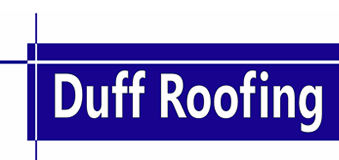Single-Ply System
- EPDM or Rubber Roofing Systems
Duff Roofing has been installing rubber roofs – that have a technical name, ethylene propylene diene terpolymer (EPDM) — since the early 1980s and have experienced a high level of success. EPDM roofs are the most commonly used low-slope roofing in the United States. What sets EPDM roofs apart from other commercial roofing systems is the availability of a manufacturer’s labor and material roof warranty. These warranties are unique as they are not pro-rated and cover labor to repair, unlike all other warranties. What this means is that the manufacturer will pay a contractor to repair your roof at no cost to the building owner if the roof system fails on its own. These warranties are invaluable to owners who have numerous roofs to manage or want the peace of mind that their leak issues would be corrected.
There are two rubber roofing manufacturers in the United States: Firestone and Carlisle. Duff Roofing has earned the Firestone Master Contractor Award (top 250 contractors in the entire United States) since 1990. Duff Roofing is also qualified to install Carlisle roofs. These manufacturers typically reserve the right to install under their names for the best contractors in the country. These manufacturers also sell some of their products to private label companies, which then sell them to less-experienced qualified roofing companies.
Manufacturers’ warranties are available for 10-year, 15-year, and 20-year systems. These are also 30-year systems available in certain circumstances.
There are three methods of attachment for EPDM roofs — each has its own advantages depending on the customer needs. Please click on the links below to learn more about these attachment methods and when they are recommended.
One of the advantages of an EPDM system is its resistance to hail damage, which is prevalent inDuff Roofing’s territory. EPDM also has a gradual aging process, which shows its remaining lifespan upon inspection before catastrophic failure.

- TPO Systems
TPO, or Thermoplastic PolyOlefin, roof systems are the fastest growing low-slope roof systems in the United States. Duff Roofing has been installing TPO systems since the mid-1990s. What sets TPO roof apart from other commercial roofing systems is the availability of a manufacturer’s labor and material roof warranty. These warranties are unique as they are not pro-rated and cover the labor to repair, unlike all other warranties. What this means is that the manufacturer will pay a contractor to repair your roof at no cost to the building owner if the roof systems fails on its own. These warranties are invaluable to owners who have numerous roofs to manage or want the peace of mind that their leak issues will be corrected.
There are numerous TPO manufacturers in the United States that offer manufacturers’ warranties. Firestone, GAF, and Carlisle are three of the largest manufacturers, and Duff Roofing is qualified to install all three systems.Duff Roofing has been a Firestone Master Contractor (top 250 contractors in the United States) since 1990.
Manufacturers’ warranties are available in 10-year and 15-year systems, with some 20-year systems possible, depending on the roof situation.
TPO systems are “heat-welded” at the seams. There are two commonly used attachment methods for TPO systems: mechanically fastened and fully adhered. In mechanically fastened systems, the TPO is “stitched” to the deck over a layer of insulation with screws. A fully adhered TPO system is when the TPO sheet is glued directly to the layer of insulation, which is attached to the deck. Mechanically fastened systems are the more common and cost-effective TPO system, but certain circumstances will require the fully adhered systems.
One of the advantages of a TPO system is its “robust” chemical make-up, which allows for good hail and weather resistance. It also has a white reflective surface, which qualifies for an “Energy Star” rating, reduces Urban Heat Index and helps systems that are under-insulated.
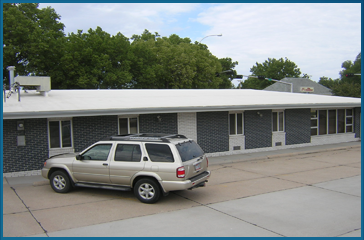
- Attachment Methods
Fully Adhered
Fully adhered systems have a layer of insulation that is fastened to the roof deck or existing roof with some prep work. This insulation is typically mechanically fastened with screws, but can also be attached with an expandable foam adhesive or, in some situations, hot tar. The rubber sheet is then glued to the insulation and walls using a special bonding adhesive.
One advantage of this system is that it allows for larger rolls of rubber to be used, which creates fewer seams. It also creates a very “clean” roof area that is easy to navigate and locate potential leaks. Thicker rubber sheets also allow for longer manufacturer’s warranty lengths. This is most commonly used in attachment method in Duff Roofing’s territory
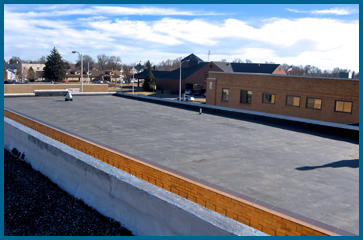
Ballasted
Ballasted systems use 1-inch diameter smooth river rock to “hold down” the rubber sheet over a layer of insulation on roof decks that are capable of supporting the weight of this system. It is typically installed over metal or concrete decks. The insulation is loose laid and the rubber sheet is laid over top with all of the walls and edges glued down.
This type of system is typically the same cost as a fully-adhered system with the initial purchase of the river rock. A large advantage is the low cost of future re-roofs, due to the ability to re-use the insulation and rock. School systems and large government entities are known to use this system so they can fit their roofing needs into a set budget, while keeping their roofs under manufacturers’ warranties.

Mechanically Fastened
Mechanically fastened systems use screws and plates to “stitch” down the rubber sheet over a later of insulation. These systems are typically used in unique situations rarely seen in Duff Roofing territories.

Asphalt Systems
- Built-up Roofs
Built-up roofs, or BUR roofs, have been installed in the United States since the 1940s. They consist of a base layer of insulation or an asphalt-soaked base sheet. There are then alternating layers of “hot” asphalt and felts to create a multiple “ply’s” of roofing. Typically, original roofs are two-, three-, or four-ply built-up roofs known as a two-ply BUR, three-ply BUR, etc. The system is then capped off by either a flood coat of asphalt, pea gravel or a modified cap sheet. When a flood coat is used, the life of the BUR roof can be extended by installing an aluminum coating on the flood coat. This protects the asphalt from harmful UV rays and weathering that breaks down the asphalt over time.
Built-up roofs need to be maintained with periodic roof inspections and repairs. Built-up roofs can also be damaged by large hail. Typically, property insurance will pay for a major repair on a BUR known as a “cap sheet.” This repair is done by adding additional layers of asphalt and felts, which are again capped off – thus the built-up roof system name. Cap sheets are typically one or two ply.
If too much moisture enters a built-up system, it will need to be completely torn off as future repair and cap sheets will be ineffective if it traps water in the system.
Duff Roofing has been installing BUR since the 1970s and can use a number of products to complete these systems. Some of the main products used by Duff Roofing are Tamko products and United Asphalt Systems. Duff Roofing built-up roofs can often be identified by the use of modified roofing on wall flashings and rooftop units. These are two of the most high-risk leak areas in a BUR system, and Duff Roofing requires the use of these higher-end products to increase the life of our BUR systems.

- Modified Asphalt Roofs
SBS-modified asphalt roofs consist of thick 3-foot-wide sheets of modified bitumen that have been “rubberized” for increased strength and weatherproofing properties. These are typically known as SBS, or Styrene Butadiene Styrene, systems. This product was introduced into the asphalt roofing industry in the 1960s and can be used in tandem with BUR system or as a stand-alone system.
SBS sheets can have a smooth surface or have granules embedded into the surface for additional protection. The smooth SBS can also be aluminum coated for additional protection from UV damage. SBS systems are typically installed by using “hot” asphalt.
Duff Roofing uses Tamko and Firestone SBS systems. Firestone offers some 10-year or 15-year manufacturer warranties, depending on the roof situation.

- Torch Down Modified Roofs
APP-modified asphalt roofs consist of thick 3-foot-wide sheet of modified bitumen that has been “plasticized” for increased strength and weatherproofing properties. These are typically known as APP, or Atactic Polypropylene, systems. This product was introduced into the asphalt roofing industry in the 1960s and can be used in tandem with BUR system or as a stand-alone system.
APP sheets can have a smooth surface or have granules embedded into the surface for additional protection. The smooth APP can also be aluminum coated for additional protection from UV damage.
APP systems are installed using an open flame torch to heat up asphalt on the back of the sheet. Due to inherent dangers of using an open flame on a roof, APP roof systems are only used in specific situations and by crews that have regional certification.

Metal Systems
- Standing Seam Panels
Standing-seam metal panels have a vertical seam that is “seamed” together with some sort of positive force. Sometimes, there is a hand or robotic seamer tool that will roll over the seam after the panels are installed. Sometimes, there is a snap-lock seam that is not reversible. Other situations have a hidden clip that is mechanically fastened within the vertical seam. Standing-seam panels come in a large variety of widths and profiles.
Standing-seam panels are typically ordered to length and are available in numerous colors. The panels have different types of coatings that hold their color. Kynar coating is common on the higher-end panels. These panels also come in different gauges with the smaller the gauge, the thicker the panel. 22- 24- and 26-gauge panels are typical for commercial applications and 26- and 29-gauge are common on residential applications. Underlayments and venting are also important factors on these systems.
Due to the raised nature of the panel seams, standing-seam roof systems can be effective on slopes as small as 1/8-inch-per-foot depending on the panel engineering.
Duff Roofing uses a number of manufacturers, including Firestone, Metal Sales, Copper Sales and Butler.
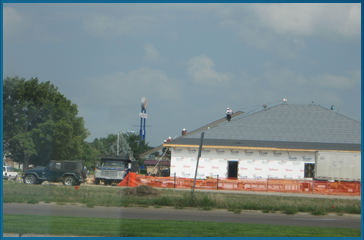
- Overlapping Panels
The most common type of metal panel on the market is an overlapping panel. There are numerous manufacturers of these styles of panels — all of which use a different name to describe them. The most basic of these is a corrugated panel, which is often seen in agriculture situations. They have a round-like profile that is overlapped at the seams. Metal buildings and residential buildings often use what is referred to as an “R” panel or a ribbed panel. They are more angular and are typically 3-foot-wide panels with a rib every 12 inches.
Overlapping panels are typically ordered to length and are available in numerous colors. The panels have different types of coatings that hold their color. Kynar coating is common on the higher-end panels. These panels also come in different gauges with the smaller the gauge, the thicker the panel. 22-, 24- and 26-gauge panels are typical for commercial applications and 26- and 29-gauge are common on residential applications. Underlayments and venting are also important factors on these systems.
Overlapping panels are dependent on the washers and screws for waterproofing, and are effective at roof slopes 2 inches per foot (2/12) or more. Effective systems have custom-made or manufacturer recommend details requiring a sheet metal shop.
Duff Roofing uses a number of manufacturers, including Firestone, Metal Sales, Copper Sales and Butler.
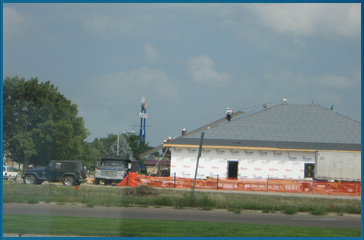
- Metal Coatings
When replacing the metal panels on a metal-roof system is cost-prohibitive, installing a metal-coating system may be the best form of repair. There are numerous coating formulations and systems on the market that are difficult to tell apart as they all look alike (white). There are two reasons to coat a roof system: The first is if the roof is leaking. The second is if the original roof panel coating has been damaged by hail.
If waterproofing is the main goal and the leak is not because of improper installation of the original panel roof, penetrations, or rooftop units, the best systems then are backed with a manufacturer labor and material warranty. These systems usually have a 10-step process that includes power washing, screw replacement, rust inhibitors, seam treatments, prime coat and final coating. These systems are often inspected by the manufacturer for approval.
If re-coating is the main goal, a number of systems without a manufacturer warranty are then sufficient.
Duff Roofing partners with GAF for the systems that require a manufacturer labor and material warranty. Typical warranty lengths on these systems are 10-year labor and material. Duff Roofing can also use systems from Henry and Tamko for simple re-coating jobs. Duff Roofing does not recommend installing spray foam on a metal roof due to differences in expansion and contraction coefficients.

